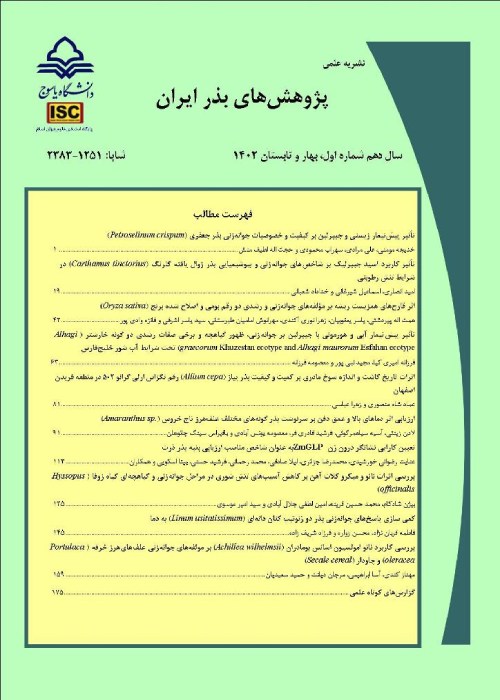Comparison of Different Models for Determining Time up to 50% Maximum Germination: A Case Study of Cottonseeds (Gossypium hirsutum)
Author(s):
Article Type:
Research/Original Article (دارای رتبه معتبر)
Abstract:
Introduction
Germination speed is one of the most important germination indices, used in most studies to compare the effects of different treatments on seed germination. Researchers use the reverse time up to 50% maximum germination (1/D50) to calculate the germination rate. One of the methods used for calculating the D50 is the utilization of nonlinear regression models such as Logestic, Gompertz, Richard, Weibull and Hill. In addition, for the purpose of calculating this parameter, simple empirical models such as the model presented by Farooq et al. and Ellis and Roberts are used. The question which arises is which of these methods has more precision predicting D50. The purpose of this study was to calculate D50, using different methods in seed germination of cotton. Material and
Methods
In this experiment, cottonseeds were placed at three temperatures of 15, 25 and 40°C with three replications, and germinated seeds were counted daily several times. To calculate D50, several nonlinear regression models including Gompertze, Logestic, Hill (the four-parameter), Richard and Weibull models were used. Moreover, for the purpose of calculating D50, the models presented by Farooq et al. and Ellis and Roberts were used.
Results
The results showed that all nonlinear regression models exhibited suitable fit to germination data. However, logestic, Hill and Weibull showed better predictability of D50, compared with other models. Besides, D50 calculated by the Farooq model was similar to that estimated by nonlinear regression models, whereas D50 estimated by the Ellis and Roberts model was higher than that estimated by other models.
Conclusions
The results of this study showed that both non-linear regression models and the model developed by Farooq could be used to calculate D50 of cottonseed. In general, the results of this study showed that nonlinear regression models could be used to calculate D50. In this research, Logestic, Hill, and Weibull showed good fit for cumulative seed germination data of cotton seeds versus time at different temperatures. These models have coefficients that have a biological concept that includes maximum germination percentage, time to 50% maximum germination and time to start germination. Moreover, when researchers only seek to measure D50 and are not familiar with the statistical software, they can use the empirical formula presented in this research. Highlights: Calculating D50 in cottonseeds, using different methods. Using nonlinear regression models to calculate D50 in cottonseeds. Developing a proper method which is more accurate, and better lends itself to calculating D50 of cottonseeds.Keywords:
Language:
Persian
Published:
Iranian Journal of Seed Research, Volume:5 Issue: 2, 2019
Pages:
1 to 13
magiran.com/p1951771
دانلود و مطالعه متن این مقاله با یکی از روشهای زیر امکان پذیر است:
اشتراک شخصی
با عضویت و پرداخت آنلاین حق اشتراک یکساله به مبلغ 1,390,000ريال میتوانید 70 عنوان مطلب دانلود کنید!
اشتراک سازمانی
به کتابخانه دانشگاه یا محل کار خود پیشنهاد کنید تا اشتراک سازمانی این پایگاه را برای دسترسی نامحدود همه کاربران به متن مطالب تهیه نمایند!
توجه!
- حق عضویت دریافتی صرف حمایت از نشریات عضو و نگهداری، تکمیل و توسعه مگیران میشود.
- پرداخت حق اشتراک و دانلود مقالات اجازه بازنشر آن در سایر رسانههای چاپی و دیجیتال را به کاربر نمیدهد.
دسترسی سراسری کاربران دانشگاه پیام نور!
اعضای هیئت علمی و دانشجویان دانشگاه پیام نور در سراسر کشور، در صورت ثبت نام با ایمیل دانشگاهی، تا پایان فروردین ماه 1403 به مقالات سایت دسترسی خواهند داشت!
In order to view content subscription is required
Personal subscription
Subscribe magiran.com for 70 € euros via PayPal and download 70 articles during a year.
Organization subscription
Please contact us to subscribe your university or library for unlimited access!


